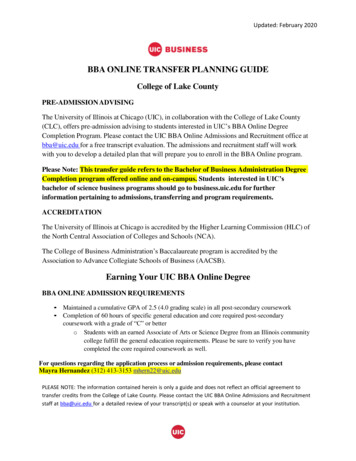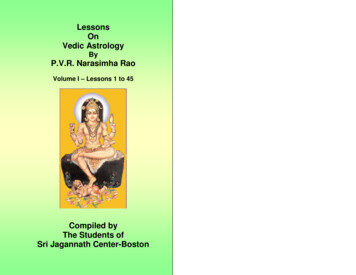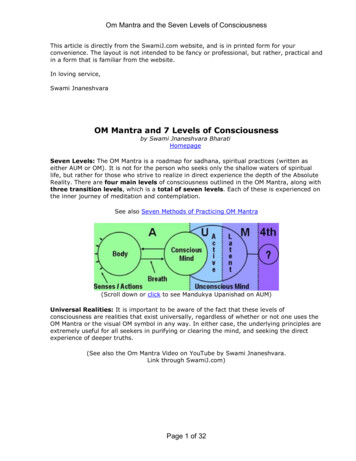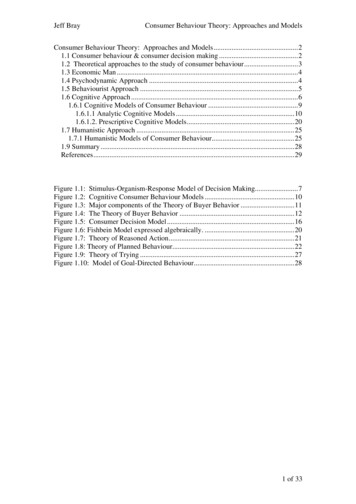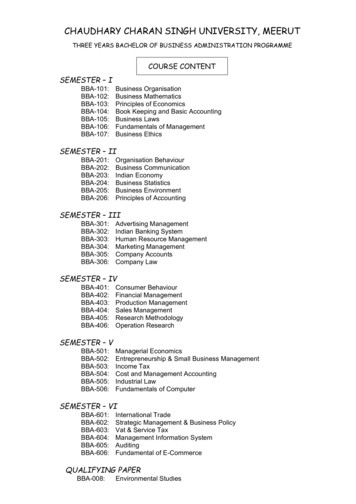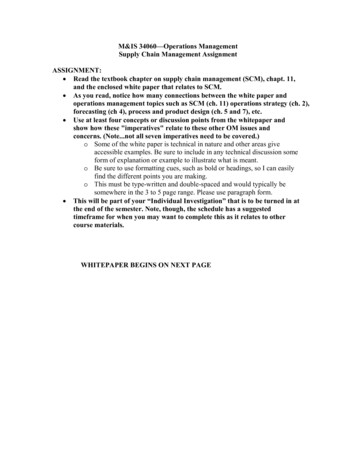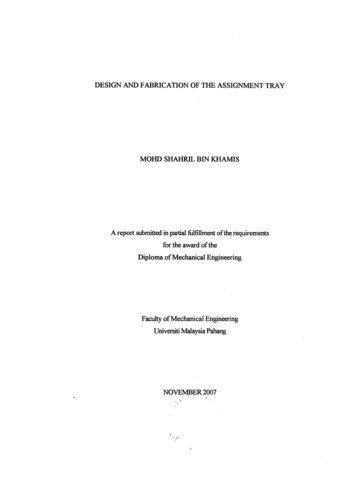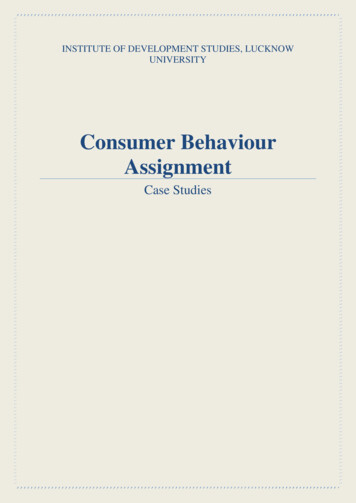
Transcription
INSTITUTE OF DEVELOPMENT STUDIES, LUCKNOWUNIVERSITYConsumer BehaviourAssignmentCase Studies
Case IConsumer Behaviour - Matin Khan – Case IExplanation of the case:Martin Incorporation was involved in the cosmetics and perfume business. The company wasfollowing the product concept of marketing and catered only to their existing customers,while paying no attention to the changing needs and demands of the consumers.A marketing graduate, named Ash, joined the company and advised the company aboutnecessary changes that must be made in the product on the basis of changing taste andpreferences of consumers to successfully sell the company s products.Mr Ash modernised the products and spent about 30 lakhs on packaging etc. on the basis ofrelevant income and social factors that affect the consumers.The product manager and assistant manager were not happy with the efforts made by Mr Ashas even after 6 months of implementation of suggested changes the company was not able toachieve effective growth in sales.The product manager and Assistant manager were of the opinion that although some progresswas made by Mr Ash, yet many important factors affecting consumer behaviour were alsoneglected by him.
Relevant Theory:In a Market, different consumers have different needs. As all consumers are unique theyexhibit different behaviour while making a purchase decision due to various factorsinfluencing consumer behaviour. Therefore it is important to understand the various factorsinfluencing consumer behaviour.Factors Influencing Consumer BehaviourThe Various factors influencing Consumer Behaviour can be classified into 4 categories: Economic FactorsPersonal FactorsCultural and Social FactorsPsychological FactorsEconomic Factors influencing consumer behaviour: Personal Income – Total Income of the consumerDiscretionary Income – Income available to a consumer after deducting taxes and basiccost of living.Disposable Income – Income available with consumer to spend according to his wishesFamily Income – Income of the family. Lower income families have less demand thanprosperous families.Consumer Expectations Regarding Future IncomeAvailability of Liquid Assets with the consumerConsumer Credit – Availability of consumer credit, Credit policiesLevel of Standard of LivingA consumer demands more and spends more with increase in his income or expectations offuture profits or availability of liquid cash or availability of credit but saves and demands lessin its absence. The nature of consumption and buying pattern of a consumer is also affectedby the income of the family and the level of standard of living.Personal Factors influencing Consumer Behaviour: Age – People of different ages have different needs.Occupation – Professionals, businessman, salaried-workers have different demands.Life Cycle Stage – Newly born, Teenager, Bachelor, Married, Parent, Grand ParentLifestyle – Achievers, Strugglers, Strivers, MakersPersonality – Aggressive, Shy, Introvert, Extrovert, Conservative, ExperimentalSelf-Concept – One s perceptions towards themselves.
Cultural Factors affecting Consumer Behaviour Culture – Culture is basically the way of living and thinking pattern that is followed fromgeneration to generation in a society. It includes knowledge, belief, traditions, morals,values, customs and other such habits that are acquired by people as members of asociety.Eg. Indian culture is entirely different from cultures of other Asian, Arabic and Westerncountries. Sub-culture – Sub-culture is a segment of culture which helps a marketer to knowanother person's culture either psychologically, socially or through mass identification.Sub-culture consists of a group of people within a culture who exhibit similar buyingbehaviour and have similar believes.E.g. Within India, buying behaviour of muslims of the north India can be differentiated formthe muslims of the south India Social class – Social class segments the market on the basis income criteria and standardof living. It refers to divisions of members of a society on the basis of education,occupation, income etc. Usually people belonging to the same social class have similarpreferences in case of choice of residence, entertainment, luxary products etc.E.g. Buying behaviour of the upper class can be easily differentiated from the middle andlower class.Social Factors influencing Consumer BehaviourSocial Group – A group is any collection of individuals with similar interests, opinions andactivities. An individual draws cues regarding consumption and disposal of products fromvarious social groups he belongs to. The various social groups an individual forms a part ofare: Reference Group – It refers to all those people which directly affect the purchase patternand decision of a consumer as they serve as a point of reference or comparison for theconsumer while making a purchase decision.Contractual Group – It includes friends, family, peers who have a direct and daily faceto face interaction with an individual. They are the most important source of influence onconsumer behaviour.Avoidance Group – A group of people that have a negative impact on a consumer. Aconsumer disassociates himself from such a group and avoid using products and servicesused, recommended or promoted by the avoidance group.Aspirational Group – It includes film stars, TV celebrities, Sport stars etc. whom aconsumer aspires to be. A consumer wants to associate himself with people he aspires anduses products and services used, recommended and promoted by them.
Opinion Leaders – It refers to a key individual in a group which influences the behaviour ofmembers of the group by providing them relevant information about new trends and productsin the market.Role and Status – Every person plays many roles in the society i.e. employee to his boss,parent to his children, referrer for young ones, advisor to peers etc. and their buying patterndepends upon the role they play in the society. People also select and buy products accordingto their status in the society. Social status of a person refers to his/her position in the societydepending upon his income, occupation, education etc.E.g. CEO of a company would prefer to buy branded products from big stores, while aworker in the same company may prefer value for money products from nearby stores.Psychological Factors affecting Consumer Behaviour:Customers behave differently towards the same marketing mix (product) due to theirrespective psychological makeup. The psychological factors that affect consumer behaviourare: Motivation – A motive is an internal force that drives a person to do something i.e. fulfilla need, achieve a goal, solve a problem. Different motives of a consumer can beunderstood through Maslow Hierarchy of needs. All consumers react differently towardsa product depending upon their position in the hierarchy. i.e. an individual will firstsatisfy his basic needs and then move upward in the hierarchy with satisfaction of eachwant.Involvement – It refers to the amount of interest or importance a consumers showstowards a product. A consumer may have high or low involvement in a product.For e.g. a cricketer will give very high importance and will be highly involved whilepurchasing a cricket bat while he may have very low involvement and interest whenpurchasing luggage bags. Perception – It is a process of selecting, organizing, and interpreting information fromour internal and external environment to form a meaningful picture. All consumersperceive the same product differently according to their own perceptions.For e.g. Wrestling is perceived differently by different people, some perceive it a meaningless fighting while some consider it a sport. Learning – It is a process which brings a permanent change in the behaviour of a person.People generally learn through past experiences and develop a certain behaviour towardsa product or service.Personality – It refers to the total of all physical, mental and moral characteristics of aperson. Customers buy products that suit their personality, for example some peopleprefer wearing formal clothes some like to wear casual clothes depending upon what suitstheir personality.
Lifestyle – A person s lifestyle is made up of his activities, opinions and interests.Lifestyle of a person also depends upon his position in the life cycle stage i.e. Teenager,Bachelor, Married etc.E.g. while teenagers or children are care free and majorly spend on recreation activities andParents are more money conscious and majorly spend on consumer durables. Attitude – Attitude is a person s predisposition to act favourably or unfavourably towardsa product, service, event, people etc. It is the way a person thinks or feels about an object.Consumers develop a positive or negetive attitude towards a product or service due to amarketing stimuli, situational variables, experience or advertising and then decide uponan intended action for that product or service.For E.g. entrepreneurs attitude towards risk, some are risk takers some like to play it safeDeterminants of Consumer BehaviourFactors influencing consumer behaviour can also be classified into Individual Determinantsand External Determinants. The individual determinants shape and determine the needs andmotives of a consumer and direct him towards a purchase, while the external determinantsindirectly influence the purchase process by filtering through individual determinants.Individual Determinants affectingConsumer BehaviourExternal Determinants affectingConsumer itudeSocial ClassPersonality and Self ConceptSocial GroupLearning and MemoryFamily and Other Influences
Consumer Decision Making ProcessConsumer Decision making is a process through which the customer selects the mostappropriate product out the several alternatives.The Consumer decision making process consists of a series of steps that a buyer goes throughin order to solve a problem or satisfy a need. They are as follows:(1) Need/Problem Recognition – A purchase process starts with a need, a problem or amotive within a consumer s mind. Any internal or external stimulus may drive a customer tobelieve that he lacks something and motivates him to look for something that will satisfy hisneed or solve his problem.(2) Information Search – When a need/problem receives heightened attention from a buyer,he become more receptive about information that may solve his problem and starts gatheringdata about products/services that will satisfy this need. He uses his personal sources (friends,family, peers etc.) and commercial sources (radio, T.V., newspapers, internet etc.) to look forrelevant information.(3) Evaluation of Alternatives – After collecting information from various sources, thecustomer evaluates the benefits and disadvantages of various product alternatives anddevelops a set of choices regarding the product attributes, brand, store etc. that suit his/herneeds, taste & preference, personality, lifestyle etc.(4) Selection and Trial – After keeping a set of choices in mind the customer makes the firstproduct trial. He may buy different products in small quantities (1 kg, 1 packet, 1 bottle) oractually use products individually for some time (tasting food, inspecting phones, taking atest drive) to form an opinion and develop an attitude towards the product.(5) Purchase Decision – When the customer believes that a product or service offers the bestsolution to his need or problem, he makes the actual purchase. This includes making aproduct choice, choosing a brand, a dealer and deciding the amount and time of purchase.(6) Post Purchase Dissonance/Behaviour – A person seeks reassurance after making apurchase. A purchase generally has the following three outcomes: Actual Performance is equal to expected performance – Customer s behaviour isnatural as the product performed according to his expectations. This leads to repeatpurchases.Actual Performance is less than expected performance – The customer is dissatisfiedas the product did not meet his expectations and hence he rejects the product.Actual Performance is more than expected performance – This leads to customerdelight/satisfaction as the product performance is better than his expectations. This leadsto customer loyalty.
Solution:Focus: New Product Development to increase sales of cosmetics and perfume productsYes, I agree with the product manager and assistant manager that efforts were made in theright direction, but many factors affecting consumer behaviour were ignored. The reasonsbeing the following:I.II.The company was using the product concept of marketing which is out dated intoday s era as now producers manufacture products that match consumer s demand,tastes and preferences. Therefore, Mr Ash should have focused on the Marketingconcept to produce and market products accordingly.The target audience was limited to the existing customers of the company. Variousnew markets must be explored to increase sales. Effective target marketing is essentialto promote and position the product effectively in the market. For example: Grooming products for men Safe and chemical free cosmetics for babies Organic and herbal cosmetics for womenIII.The market for cosmetics was not effectively segmented by Mr Ash. Cosmeticsmarket can be segmented effectively by dividing the market into groups which arehomogenous within and heterogeneous among themselves on the basis of their age,gender, occupation etc. For e.g. Market can be segmented into: Working women, Housewife, Teenage girls Daily consumers, Beauty Parlours, Film Industry Rich people, Middle class people, Low income groupIV.While attention was paid to income and social factors many personal factors such asAge, Occupation, Lifestyle, personality of a consumer were neglected. For e.g. Age: Working women, elderly women, Teenage girls all have different needs. Income: The rich pay more attention to how they look than people with lessincome. Occupation: A Housewife has simple beauty needs as she stays at home mostof the time while a working lady has more intensive beauty needs as she goesout of the home every day and has to look presentable in the office. Personality: Traditional women and Modern women both have differentneeds. Some prefer expensive perfumes while some use natural fragrances like‘itra’. Attitude: People have different attitude towards chemicals in beauty products.Some prefer it while some dislike it and prefer herbal and organic products. Lifestyle: While urban people make use of deodorants and perfumes to smellgood, rural population prefers use of soaps, sandalwood and itr to smell good.Keeping the income factors in mind no changes were made in product quantities i.e.small units of previous products. Keeping in mind the social factors no efforts wereV.
VI.VII.made to use opinion leaders like celebrities or doctors which would have been moreeffective in influencing sales than change in product packaging.Existing products were modernised while no attention was paid to new productdevelopment for new potential markets in cosmetics industries. For e.g. Groomingproducts for menNo efforts were made to advertise the products to targeted audience or reposition thebrand according to the changing customer taste and preferences. No offers, discountsor sales promotion activities were carried out by Mr Ash to boost sales.Other Factors that should have been considered are:I.II.III.IV.V.VI.Age – Babies, Teenagers, Middle aged people and elderly all have different needs andrequirements related to cosmetics and beauty products. Therefore the target audiencecould have been segmented on the basis of age of consumers.Occupation – Working ladies v/s Housewife, Clerical staff v/s Top management,Daily consumer v/s consumers from Fashion IndustryWhile a housewife, a normal clerk and daily consumer may have nominal needs anddemand basic products, working ladies, Directors and CEO s of a company, make-upartists, beauticians, film stars may have specific needs and high demand for beautyproducts. Products could have been designed and developed for one or few segmentson the basis of their occupation.Standard of Living – Rural v/s Urban People, Low income group v/s High incomegroupWhile rural people and low income groups may make use of soaps and traditionalproducts, urban people and the high income group are more inclined towardsexpensive beauty products. Different products could have been developed for both thesegments and different pricing strategies could have been followed.Perception & Attitude – Chemicals v/s Organic/Herbal productsWhile some people perceive beauty products negatively due to chemical ingredientsin them some people recommend them. Market share for both chemicals and organicproducts could have been analysed and the more profitable market could have beentargeted.Involvement – Normal consumers v/s Film IndustryConsumer segments like make-up artists, beauticians, film starts will have a highinvolvement in buying beauty products than normal consumers. Therefore dependingupon the target market packaging and labelling strategies should have been made.Culture – Due to different cultural norms regarding appearances laid down bydifferent religions, men and women of a particular religion dress up and make use ofspecific cosmetic products. For e.g. Hindu, Jain and Bengali women use ‘sindoor’ and‘Bindi’ while Muslim women do not, Sikh men don’t use shaving products as they arenot allowed to cut hair, Many Jain men and women use white tikka.
VII.VIII.Opinion Leaders – Celebrities and Doctors act as effective opinion leaders forcosmetics and beauty products which could have been used and their impact on thesales, brand value and price could have been analysed.Personality and Self-concept – Alpha Males v/s Passive males, Feminine v/sTomboyish girlsWhile alpha males and feminine girls may use and encourage use of beauty productswhile passive males and tomboyish girls may like to stay raw and refrain from usingbeauty products.
Case IVConsumer Behaviour - Matin Khan – Case IV
Explanation of the case:A company in the food industry wants to formulate an effective marketing strategy to attracthealth conscious consumers. For this purpose a survey was conducted as more and moreconsumers are becoming health conscious and prefer to consume foods that are healthy andnutritious. The goal of the survey was to collect information about food habits and attitude ofthe consumers towards different food items.On the basis of the survey the consumers were divided into three categories: Old Consumers (elderly people)Young Consumers (teenagers, unmarried, working singles)Middle Aged Consumers (Big Families, Married Couples)And the following information was found:Old Consumers: They were health conscious, Brand loyal and highly involved in buyingfood items. This is due to their medical considerations, restricted choice of food and fixedeating schedules. They do not prefer to eat outside and are very cautious while buying newproducts.Young Consumers: They are less health conscious and less brand loyal than older peopleand have less involvement in buying food items. They prefer food on-the-go and likeconvenience/fast food more than cooking for themselves. They are more influenced byproduct appeals than the brand name or price of the product.Families and Households: They are moderately health conscious, moderate brand loyal andare very particular about their purchases of food items. They prefer to cook their own foodand their purchases are restricted by a fixed budget. They focus more on the brand, quality,quantity and price of a product rather than product appeals. This segment usually consists ofbig families and married couples with kids who look for value of money products.
Relevant Theory:Diffusion of innovation is a theory that seeks to explain how, why, and at what rate newideas and technology spread. Diffusion is the process by which an innovation iscommunicated over time among the participants in a social system. The origins of thediffusion of innovations theory are varied and span multiple disciplines.Rogers proposes that four main elements influence the spread of a new idea: the innovationitself, communication channels, time, and a social system. This process relies heavily onhuman capital. The innovation must be widely adopted in order to self-sustain. Within therate of adoption, there is a point at which an innovation reaches critical mass.The categories of adopters are innovators, early adopters, early majority, late majority, andlaggards. Diffusion manifests itself in different ways and is highly subject to the type ofadopters and innovation-decision process. The criterion for the adopter categorization isinnovativeness, defined as the degree to which an individual adopts a new idea.Consumer AdoptionConsumer adoption deals with the purchase behaviour of consumers relating to a productafter they have become aware of it. When a new product is introduced in a market, someconsumers buy (adopt) it very quickly, some consumers wait for assurances from early usersto make their first purchase, while a majority of consumers buy it only when the product istried and tested in the market or only when it is necessary for them to buy it.Markets constantly try to influence customers to adopt new products and services, therefore itis necessary for them to identify and understand the behaviour of various groups of customerson the basis of how slow or fast do they adopt a product or service or how much time do theytake to adopt a new product or service.Classification of AdoptersConsumers may be divided into five groups on the basis on time taken by them to adopt anew product or service during its life cycle. They are: Innovators (2.5%) – Innovators amount for only 2.5% of the consumers. Innovatorsare early buyers and risk takers, they are the first to purchase the product at thebeginning of its life cycle. They are adventurous people, who like to try new productsand stay updated with the latest products and trends, they do not hesitate to pay apremium price for the benefit and are always eager to learn more about latest productsfrom magazines, T.V., internet. Early Adopters (13.5%) – The next 13.5% purchasers are early adopters who takecalculated risks before buying a new product. They are generally opinion leaders of agroup and the success of the product greatly lies upon their adoption of the product.Early adopts weighs the pros and cons of the product before buying it and uponsatisfaction help the product to become socially acceptable by providing informationto their social groups.
Early Majority (34%) – The early majority are cautious people who only buy aproduct when it has been accepted by the early adopters and innovators. They arewell-educated buyers who do not have the time or resources to research a product andrely on personal sources for information regarding products and services. They do notbuy the product until it is socially acceptable and successful. Late Majority (34%) – It consists of 34% of the late consumers who adopt a newproduct only due to social pressures or non-availability. These consumers are lesseducated and therefore are very skeptical in nature. They rely on informal sources forinformation and make a purchase only after the majority has already purchased it. Laggards (16%) – The last 16% of the buyers are traditional or elderly people withlittle or no social interaction, who show great resistance towards adopting a newproduct. Some laggards never purchase a product while others purchase it at the endof its life cycle. They are uneducated people with low status and earnings and theypurchase a product only when the existing product is out of use (broken and cannot berepaired).Conclusion:Marketers aim to identify and focus on innovators and early adopters and offer pricepromotions or free trials or samples backed by extensive advertisement for these groups.Early adopts work as change agents for the product and help to overcome resistance from thepublic and influence other consumers to adopt or buy the product. Therefore marketers firstfocus on early adopters capable of becoming opinion leaders whom others groups will follow.Special care must be taken in identifying these groups as an innovator for cars may be alaggard for bikes.After the early majority has been satisfied, special strategies are formed for late majority andlaggards offering huge discounts, guarantees and other marketing tactics.Family Influence on Consumer BehaviourA family is an important element that affects the consumption and disposal of products by anindividual. A family may be defined as two or more people living together, related by bloodor marriage who share a common house, common income and similar status and values.A family is a social group and all members of a family influence and get influenced by eachother. Family bonds are stronger than bonds in any other group and all members of the familyform a single decision unit in case of purchase of products and services for commonconsumption. Each member influences and gets influenced by a family member dependingupon his/her role, life cycle stage and relationship dynamics in the family.Therefore, family influence on consumer behaviour can be understood by studying thebuying roles, family dynamics and life cycle stage of a family member.
Buying Roles of a Family - The various roles played by members of a family while makinga purchase decision are: Influencer – The family member or family members who provide information about aproduct or service to other family membersGate Keeper – Family members who controls the flow and direction of the contents ofinformationDecider – The one with the power to select the product whether individually or jointlyBuyer – The one who makes the actual purchasePreparer – The family member or family members who prepare the product for familyconsumptionUser – The consumers of the product or serviceMaintainer – The members who maintain the product for continued use and satisfactionDisposer – The member who disposes the product.Family Dynamics - Family influence on consumer behaviour exists due to the relationshipdynamics between family members. The buying behaviour of a family and its membersbasically depend upon the dynamics of husband-wife in decision making. There may be thefollowing types of decisions on the basis of husband-wife influences – Wife Dominant Decisions, E.g. grocery, food, home decorationHusband Dominant Decisions, E.g. phone, cars, insuranceJoint Decisions, E.g. vacations, schools for childrenAutonomic or Unilateral decisions, E.g. milk, newspaperFamily Life Cycle stages - The buying behaviour of a family member is also influenced byhis position in the family life cycle stage. Different stages in the life cycle show familyinfluence on consumer behaviour with respect to a family member s position in the life cyclestage. The family life cycle stages and consumption patterns of each stage can be understoodwith the table below:
Solution:Focus: Effective Marketing Strategy for Healthy food productsThe following points can be inferred from the study: Consumers are more aware now, they do not simply buy what is available but demandspecific productsThe user may not always be the buyerDifferent consumers may perceive the same products differentlyDifferent Consumers adopt the same product at different stages of product life-cycleFACTS ABOUT ELDERLY CONSUMERS: Older people are more health conscious due to medical and health considerations They have a restricted diet and they do not change their taste and preference towardsfood frequently They are more brand conscious and brand loyal than other segments Older people have high involvement in buying food products as some food may beharmful to them therefore they check all product attributes before buying They are regular consumers and will prefer home delivery than purchasing food fromoutside They are Late Majority and Laggards in the product life-cycle stage, rarely try newproducts They have a negative attitude towards canned/packed food and fast-food The user may not be the actual buyerFACTS ABOUT YOUNG CONSUMERS: Young consumers are less health conscious than other segments and prefer outsidefood They are less involved in buying food products as they have a hectic work scheduleand dynamic lifestyle and like to try new products They are early adopters therefore they can be used as innovators and opinion leadersto influence the early and late majority consumers They prefer to eat outside and shop outside They are impulsive buyers and buy at convenience, their purchase decision is highlyinfluenced by attractiveness of the product They are less brand loyal and focus more on product appeals than price or brand ofthe product The user is the actual buyer
FACTS ABOUT MIDDLE-AGED CONSUMERS: They are less brand loyal but very health conscious This segment usually consists of big families, Married people with kids They too like elderly have a negative attitude towards canned/packed food and aresceptical towards outside food They resort to traditional products and do not try new and innovative products They lie in the late majority and laggards i.e. they only buy a product when it issuccessful in the market Due to large number of end users (family members) they have a restricted budget andthey like to store product in large quantities The user may not be the actual buyerThe above information can be used in the following ways to formulate an effective marketingstrategy – On the basis of the above information Older and Middle aged segment can prove to bea better market than young consumers. Therefore marketing efforts must be directedtowards elderly people, big and small families and married couples. Health conscious c
Opinion Leaders – It refers to a key individual in a group which influences the behaviour of members of the group by providing them relevant information about new trends and products in the market. Role and Status – Every person plays many roles in the society i.e. employee to his boss, parent to his children, referrer for y
